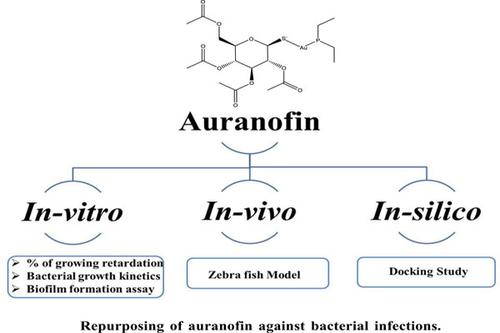Current Computer-Aided Drug Design ( IF 1.5 ) Pub Date : 2021-07-31 , DOI: 10.2174/1386207323666200717155640 Nidhi Sharma 1 , Arti Singh 1 , Ruchika Sharma 2 , Anoop Kumar 1

|
Aim: The aim of the study was to find out the role of auranofin as a promising broadspectrum antibacterial agent.
Methods: In vitro assays (Percentage growth retardation, Bacterial growth kinetics, Biofilm formation assay) and In silico study (Molegro virtual docker (MVD) version 6.0 and Molecular operating environment (MOE) version 2008.10 software).
Results: The in vitro assays have shown that auranofin has good antibacterial activity against Gram positive and Gram negative bacterial strains. Further, auranofin has shown synergistic activity in combination with ampicillin against S. aureus and B. subtilis whereas in combination with neomycin has just shown additive effect against E. coli, P. aeruginosa and B. pumilus. In vivo results have revealed that auranofin alone and in combination with standard drugs significantly decreased the bioburden in the zebrafish infection model as compared to control. The molecular docking study have shown good interaction of auranofin with penicillin-binding protein (2Y2M), topoisomerase (3TTZ), UDP-3-O-[3-hydroxymyristoyl] N-acetylglucosaminedeacetylase (3UHM), cell adhesion protein (4QRK), β-lactamase (5CTN) and arylsulphatase (1HDH) enzyme as that of reference ligand which indicate the multimodal mechanism of action of auranofin. Finally, MTT assay has shown the non-cytotoxic effect of auranofin.
Conclusion: In conclusion, auranofin in combination with existing antibiotics, could be developed as a broad spectrum antibacterial agent; however, further studies are required to confirm its safety and efficacy. This study provides the possibility of the use of auranofin apart from its established therapeutic indication in combination with existing antibiotics to tackle the problem of resistance.
中文翻译:

金诺芬抗细菌感染的再利用:计算机和体外研究
目的:该研究的目的是找出金诺芬作为一种有前途的广谱抗菌剂的作用。
方法:体外测定(生长迟缓百分比、细菌生长动力学、生物膜形成测定)和计算机模拟研究(Molegro 虚拟码头 (MVD) 6.0 版和分子操作环境 (MOE) 2008.10 版软件)。
结果:体外试验表明,金诺芬对革兰氏阳性和革兰氏阴性菌株均具有良好的抗菌活性。此外,金诺芬与氨苄青霉素组合对金黄色葡萄球菌和枯草芽孢杆菌显示出协同活性,而与新霉素组合对大肠杆菌、铜绿假单胞菌和短小芽孢杆菌刚刚显示出累加作用。体内结果表明,与对照相比,单独使用金诺芬和与标准药物联合使用可显着降低斑马鱼感染模型中的生物负载。分子对接研究表明金诺芬与青霉素结合蛋白(2Y2M)、拓扑异构酶(3TTZ)、UDP-3-O-[3-羟基肉豆蔻酰] N-乙酰氨基葡萄糖脱乙酰酶(3UHM)、细胞粘附蛋白(4QRK)、β-内酰胺酶 (5CTN) 和芳基硫酸酯酶 (1HDH) 酶作为参考配体,表明金诺芬的多模式作用机制。最后,MTT 测定显示金诺芬的非细胞毒性作用。
结论:综上所述,金诺芬与现有抗生素联用,可开发为广谱抗菌剂;然而,需要进一步的研究来证实其安全性和有效性。这项研究提供了使用金诺芬的可能性,除了其既定的治疗适应症与现有的抗生素相结合来解决耐药性问题。











































 京公网安备 11010802027423号
京公网安备 11010802027423号